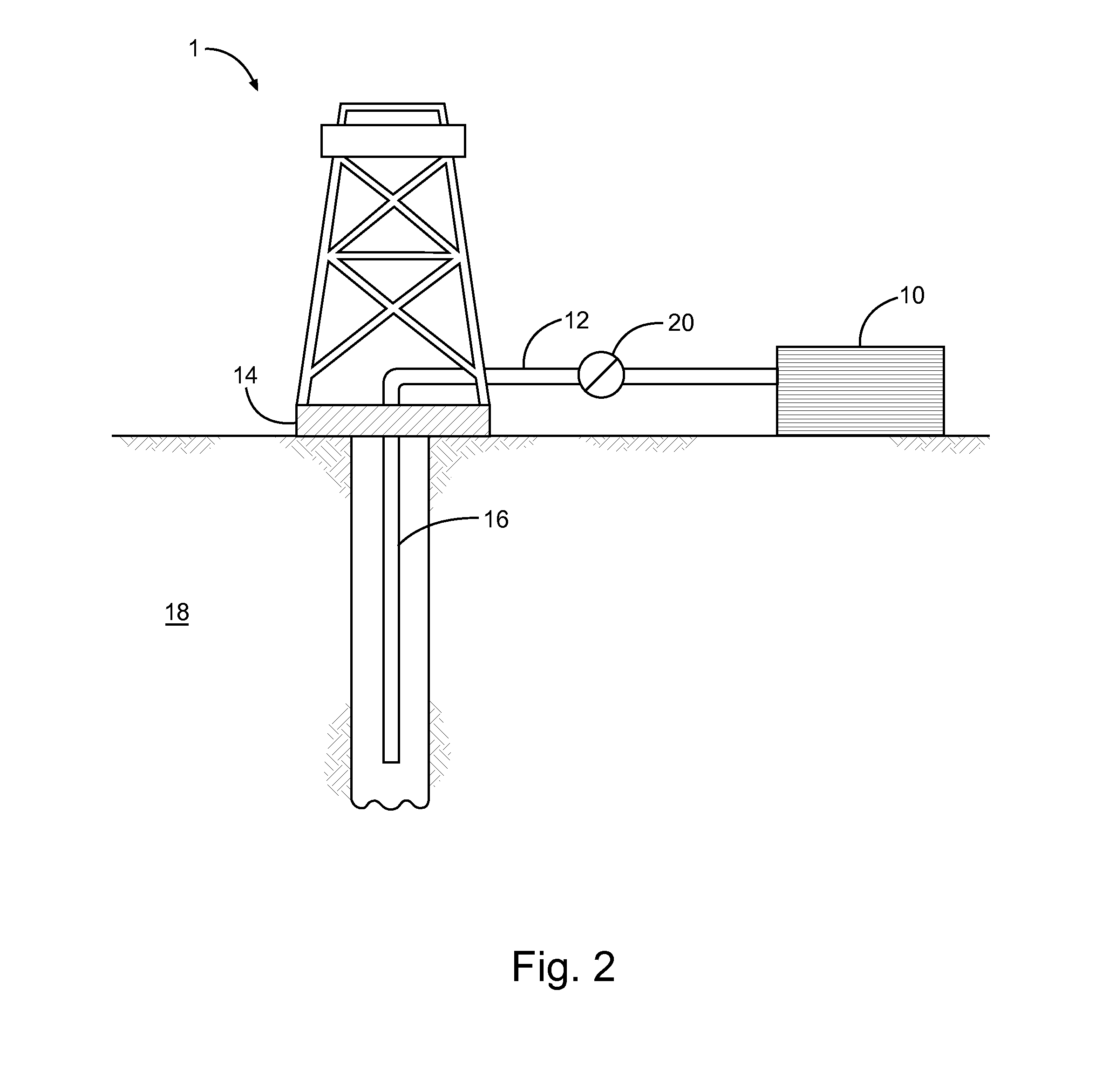Viscosifier for treatment of a subterranean formation
- Summary
- Abstract
- Description
- Claims
- Application Information
AI Technical Summary
Benefits of technology
Problems solved by technology
Method used
Image
Examples
example 1
Preparation of Fluid Samples
[0124]Three different water-based fluids were formulated by adding different viscosifiers in deionized water as shown in Table 1.
TABLE 1Additives in deionized water for Fluids I to III.FluidContentFluid I0.75 ppb BARAZAN ® D PLUSFluid II0.17 ppb acrylamide polymerFluid III0.34 ppb acrylamide polymer
[0125]Fluid I was made by adding to deionized water BARAZAN® D PLUS (xanthan gum powder with dispersion additives) at a concentration of 0.75 ppb (pounds per barrel) and mixing until homogenous. Fluid II was made by adding to deionized water an acrylamide / 2-acrylamido-2-methyl-1-propanesulfonic acid copolymer (having about 50 mol % monomers derived from acrylamide, about 50 mol % monomers derived from 2-acrylamido-2-methyl-1-propanesulfonic acid, and a molecular weight of about 8,000,000 g / mol) at a concentration 0.17 ppb and mixing until homogenous. Fluid III was made by adding to deionized water the acrylamide polymer used to make Fluid II at a concentration ...
example 2
[0126]Table 2 shows FANN-35 Rheology of fluids I, II and III measured at 25° C. and standard pressure.
TABLE 2FANN-35 Rheology (0.2X spring) for Fluids I to III.The dial readings on FANN-35 at various shearingconditions (rpm) have units of lb / 100 ft2.Fluid No.Fluid IFluid IIFluid IIICompositionBARAZAN ® D0.17 ppb0.34 ppbPLUS (0.75 ppb)acrylamideacrylamidepolymerpolymerRheology (@25° C.)600 rpm, lb / 100 ft2676090300 rpm, lb / 100 ft2484064200 rpm, lb / 100 ft2423152100 rpm, lb / 100 ft23222396 rpm, lb / 100 ft21511183 rpm, lb / 100 ft212916Plastic viscosity, cP192026LSYP, lb / 100 ft29714
[0127]The data shown in Table 2 shows that the viscosity readings of the Fluid I falls between that of Fluids II and III. The data also demonstrates that the acrylamide polymer-based Fluids II and III had excellent low shear rheology (6 RPM and 3 RPM). The data further indicates that, compared to BARAZAN® D PLUS, about ¼th to ⅓rd amount of the acrylamide polymer is sufficient to achieve equivalent performa...
example 3
[0129]The cost of the acrylamide polymer used to make Fluids II and III was about $8-$8.5 / lb. The cost of BARAZAN® D PLUS is about $2.5 / lb. However, compared to BARAZAN® D PLUS, only about a quarter to a third of the amount of the new acrylamide polymer was sufficient to achieve the equivalent performance. Thus, the effective cost for the new polymer can be $2-$2.6 / (fluid unit) as compared to $2.5 / (fluid unit) of BARAZAN® D PLUS to achieve equivalent viscosification of the given amount of fluid. Therefore, utilization of the new acrylamide polymer instead of BARAZAN® D PLUS can result in about 20% or more cost savings.
PUM
| Property | Measurement | Unit |
|---|---|---|
| Temperature | aaaaa | aaaaa |
| Temperature | aaaaa | aaaaa |
| Density | aaaaa | aaaaa |
Abstract
Description
Claims
Application Information
 Login to View More
Login to View More - R&D
- Intellectual Property
- Life Sciences
- Materials
- Tech Scout
- Unparalleled Data Quality
- Higher Quality Content
- 60% Fewer Hallucinations
Browse by: Latest US Patents, China's latest patents, Technical Efficacy Thesaurus, Application Domain, Technology Topic, Popular Technical Reports.
© 2025 PatSnap. All rights reserved.Legal|Privacy policy|Modern Slavery Act Transparency Statement|Sitemap|About US| Contact US: help@patsnap.com



